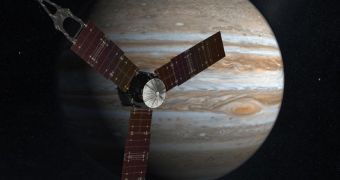Experts at the NASA Goddard Space Flight Center (GSFC) announce that they have just delivered the magnetometers that will go on the Juno spacecraft to the Lockheed Martin corporation, in Denver.
Juno will be the next NASA mission to Jupiter, and is currently scheduled to launch in 2011. The mission will carry advanced magnetometers, that will be used to measure the intensity of Jupiter's magnetic field.
The high-tech instruments were designed and constructed by a Goddard team of technicians, scientists and engineers, and were delivered to Lockheed because the company is the main contractors for building the actual spacecraft.
Experts expect that the tools will be able to provide NASA with high-accuracy maps that show how Jupiter's magnetic fields vary over time in specific regions of the planet, which may yield clues to the gas giant's internal structure.
In addition to the instruments themselves, each of the two vector magnetometers will also carry a pair of non-magnetic star cameras. These tools will be used to ensure that the spacecraft is aware of its location in space with great accuracy and at all times.
“Juno's magnetometers will measure Jupiter's magnetic field with extraordinary precision and give us a detailed picture of what the field looks like, both around the planet and deep within,” explains GSFC scientist Jack Connerney.
“This will be the first time we've mapped the magnetic field all around Jupiter – it will be the most complete map of its kind ever obtained about any planet with an active dynamo, except, of course, our Earth,” adds the expert.
Connerney is also the leader of the magnetometer team, and the deputy principal investigator of the Juno mission. The team that designed the magnetometers was led by John Jorgensen, who is based at the Danish Technical University in Copenhagen, Denmark.
“The magnetometers play a unique and important role in Juno's investigation of the formation and evolution of Jupiter,” adds expert Scott Bolton, from the Southwest Research Institute in San Antonio.
“They provide one of the ways that Juno will see deep inside the giant planet, and this will help us understand how and where Jupiter's powerful magnetic field is generated,” says Bolton, who is also the principal investigator of the Juno mission.
The new flight, the second in NASA's New Frontiers program, will be managed by the Jet Propulsion Laboratory (JPL), a division of the California Institute of Technology (Caltech), in Pasadena.
Juno will carry a complex suite of nine instruments, that will help experts investigate the existence of a solid planetary core, map Jupiter's intense magnetic field, measure the amount of water and ammonia in the deep atmosphere, and observe the planet's auroras.
“With Juno, we will learn much more about the structure and evolution of Jupiter, and this will help us understand our own solar system,” Connerney reveals.
“But astronomers have now found many other giant planets outside our solar system. What we learn about Jupiter also will help us understand the planets orbiting other stars,” he concludes.

 14 DAY TRIAL //
14 DAY TRIAL //